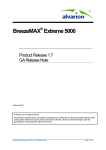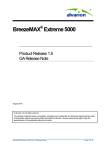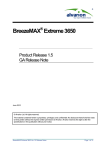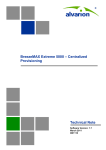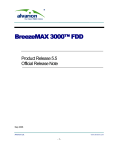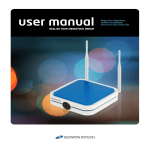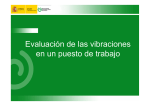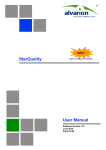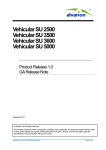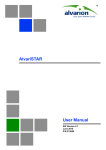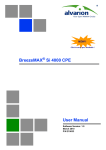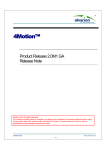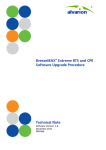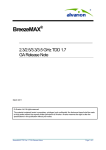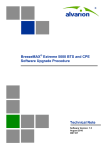Download BreezeMAX Extreme Version 1.8 GA Release Notes
Transcript
® BreezeMAX Extreme 5000 ® BreezeMAX Extreme 3650 ® BreezeMAX Extreme 3600 Product Release 1.8 GA Release Note November 2011 © Alvarion Ltd. All rights reserved. The material contained herein is proprietary, privileged, and confidential. No disclosure thereof shall be made to third parties without the express written permission of Alvarion. Alvarion reserves the right to alter the specifications in this publication without prior notice. BreezeMAX Extreme Ver.1.8 GA Release Notes Page 1 of 19 General This document details the main hardware elements, software features, known limitations, bug fixes, and version compatibility information as well as the documentation available for the BreezeMAX Extreme 5000, BreezeMAX Extreme 3600, BreezeMAX and Extreme 3650 product release 1.8. It corresponds to the following software versions: • Software version 1.8.1.24 of BreezeMAX Extreme 5000 / 3600 / 3650 base-station • Software version 1.8.1.14 of BreezeMAX PRO 5000 CPE • Validated with software version 7.0.8 of BreezeMAX PRO 3000 CPE The Released Product BreezeMAX Extreme is a state-of-the-art all-outdoor, all-in-one WiMAX 16e (IEEE 802.16e-2005) based platform, operating in TDD, and intended for worldwide use. BreezeMAX Extreme includes 3 product family models, addressing different frequency bands, specifically: BreezeMAX Extreme 5000 operates in the 5.x GHz band (4.9-5.9 GHz), BreezeMAX Extreme 3600 operates in the 3.6 GHz ETSI band (3.6-3.8 GHz), and BreezeMAX Extreme 3650 operates in the 3.65 GHz band for North America (3.65-3.7 GHz). BreezeMAX Extreme offers all the advantages of the WiMAX 16e to the licensed, semi-licensed and licensed-exempt frequency bands. Leveraging the carrier class QoS along with the superior radio technology, formed in a small all-outdoor highly integrated design presenting an exceptionally attractive cost/performance ratio for various needs and deployment scenarios, improving operational costs and reducing complexity. The BreezeMAX Extreme base-station comes in the following frequency configurations: Product Family Product Model Frequency Range 4.9 model 4.90-5.35 GHz 5.4 model 5.47-5.95 GHz BreezeMAX Extreme 3600 3.6 model 3.60-3.80 GHz BreezeMAX Extreme 3650 3.7 model 3.65-3.70 GHz BreezeMAX Extreme 5000 The BreezeMAX Extreme PRO 5000 CPE covers the entire 1GHz band (4.9-5.9) in a single model. BreezeMAX PRO 3000 CPE supports ETSI and FCC bands. Several CPEs are supported under interoperability (IOT) and are listed in the following chapters. Usage of the Extreme system should be done in compliance with the local laws and regulations. Please refer to the following section for information on country codes and regulation compliance. BreezeMAX Extreme Ver.1.8 GA Release Notes Page 2 of 19 Supported Country Codes With BreezeMAX Extreme release 1.8, the following country profiles are allowed for use. Any other country profile is prohibited: Extreme 3600 Extreme 3650 Extreme 5000 4.9 GHz Model Extreme 5000 5.4 GHz Model Universal Australia ETSI Universal FCC Canada Universal Canada FCC ETSI 5.1 GHz FAA Universal Canada Australia ETSI FCC* India Taiwan 5.8 Important notes: ONLY experienced installation professionals who are familiar with radio equipment for outdoor/indoor, local radio regulations, relevant local building and safety codes and, wherever applicable, are licensed by the appropriate government regulatory authorities should install outdoor units and antennas and should do so in accordance to the local applicable regulations. * With Release 1.8, FCC certification for the 5.4 GHz band is available and can be used on units marked with FCC ID LKT-EXTR-50 (supporting 5.4 and 5.8GHz). Units marked with FCC ID LKT-EXTR-58 can be used with the 5.8GHz only. Due to the requirements of FCC regulations, starting with release 1.5.1.72, once setting the country code to FCC it would not be able to further modify the country code to any other country band. BreezeMAX Extreme Ver.1.8 GA Release Notes Page 3 of 19 About this Release Release 1.8 of the BreezeMAX Extreme is based on release 1.7 and introduces enhancements and new features. Release 1.8 introduces the following new elements and capabilities. Extreme BTS Product Models Supporting all the previously available models: • Single Sector SISO – A Single Input Single Output solution, serving a single sector, comes with either integrated or external antenna • Single Sector MIMO – A Multiple Input Multiple Output solution, serving a single sector, comes with either integrated or external antenna • Dual Sector SISO – A Single Input Single Output solution, serving two sectors, comes with external antenna Model Extreme 3600 Extreme 3650 Extreme 5000 Single Sector SISO No No Yes Single Sector MIMO Yes Yes Yes Dual Sector SISO Yes Yes Yes Extreme CPE Product Model Supporting previously released models: • PRO 5000: Outdoor, MIMO CPE, 2Rx 1Tx, Integrated dual-slant antenna • PRO 5000: Outdoor, MIMO CPE, 2Rx 1Tx, External antenna (2 N-Type connectors) • PRO 3000: Outdoor, MIMO CPE, 2Rx 1Tx, Integrated dual-slant antenna • PRO 1000: Outdoor, SISO CPE, 1Rx 1Tx, Integrated vertical antenna or external antenna End-to-End System Components New in this release: • IOT with Self Install CPE for the 3.6 GHz band - WM5347N-3G6 (V2.8.8.1-Z20128) Supporting also previous end-to-end elements: • All-outdoor Extreme BTS, with the following integrated capabilities o ASN-Gateway o GPS receiver o Integrated dual-slant antenna (external antenna model also available) o Local provisioning option (no AAA mode) • PoE to feed the BTS (for Extreme 5000 model only) • BTS cabling for power (PoE or DC), data, external antennas • GPS antenna kits (Basic and High-Profile models) • GPS Chaining cable (for multi sector site) • Sector Antennas (for external antenna model) BreezeMAX Extreme Ver.1.8 GA Release Notes Page 4 of 19 • Outdoor CPE • PoE to feed the CPE • SAU – Subscriber Alignment Unit, for ease of installation and alignment of CPEs (PRO 5000 and PRO 1000 only) • AAA IOT: Radiator (verified with version 4.4), Alepo (verified with version 7.3), FreeRADIUS (verified with version 2.1.8), Aradial (verified with version 5.2.3) • ASN IOT: Integrated, external over R6 with 4Motion mini-centralized ASN • NMS: • o AlvariSTAR – Network Management System o StarACS – TR69 based CPE Management System Installer Aid: o AlvariCRAFT – Element Management and Installation Assistance Application Main Features The following new features and functionalities are supported with this release: • Redundant AAA Support Support for a redundant AAA option. In case connection to the primary AAA fails, the base station would resume seamless operation with the secondary (redundant) AAA server. Assumptions are that both AAAs are fully synchronized with respect to their database (either using the same database or taking care of full replication). • Proportional Rate Fair Scheduling o Supporting the option of automatic down scaling of the service commissioned to CPEs in case their modulation drops below the configured modulation threshold. The main reason for such requirements is in the case of loaded sectors (reaching full frame utilization) in which subscribers with lower modulations affect the entire sector performance (since it takes a longer period of time for it to satisfy the MIR, consuming longer air time). o The configurable parameters include: The threshold MCS – CPEs connected at lower rate (MCS) than the threshold would have their services scaled (sector level parameter) Scaling factor – controlling the “slope” of the scaling (sector level parameter) Individual CPEs can be excluded from the scaling – i.e. CPEs subject to higher SLA can be excluded from the scaling mechanism such that regardless to their modulation they would be aimed to receive their full commissioned service Minimal PFS correction – Leveraging the mechanism of the PFS, this feature automatically limits the services to CPEs with the lowest modulation (QPSK ½ MIMO A) to 4Mbps and thus improves and tunes their service and packet flow to their air link conditions. As this capability depends on the CPE support in dynamic service flow change, it is enabled by default in Extreme 5000, and disabled by default in the 3GHz models. BreezeMAX Extreme Ver.1.8 GA Release Notes Page 5 of 19 • Enhanced Dual-Carrier Operation and Feature License o • Starting with release 1.8, the base station models, having dual-carrier enabled, and external antenna connectors can be configured to either MIMO or DUAL-SISO. Namely: DUAL-SISO base station model – would have operation mode configuration option as a MIMO SINGLE sector (having dual-carrier supporting 10+10 MHz) MIMO external antenna model – once loaded with the “Extended Channel Bandwidth” feature license, enabling the dual carrier would have configuration option as a DUALSISO operation mode. Support for upper 25MHz of 3.65 GHz band Starting with release 1.8, BreezeMAX Extreme 3650 supports for FCC and IC the 3.675-3.7GHz band. As required by the standard, operation in the upper 25MHz is supported with contention based protocols coexistence. The BreezeMAX Extreme will detect the channel currently in use, and will shift a channel based on the DCS (Dynamic Channel Selection) mechanism. • Support for FCC 5.4 GHz As certification was resumed in this band, and granted for BreezeMAX Extreme 5000, starting with release 1.8, Extreme base stations running under FCC can use either the FCC 5.8 sub-band or the FCC 5.4 sub-band. • Enhanced Operation Capability – Real-Time Operating Frequency Modification Ability to modify the current base station operating frequency in real time, without the need to reboot the base station for the parameter modification to take effect. • Enhanced Operation Capability – RADIUS accounting START/STOP over Eth CS With release 1.8, it is possible to also enable “ACCOUNT START” and “ACCOUNT STOP” indications for Ethernet CS services (VLAN .1p or .1q). This feature comes on-top of the existing capability of ACCOUNT START/STOP messages under transparent service group. • Enhanced Operation Capability – Radio Channels Persistent Configuration Enabling control over SNMP to turn the radio channel “OFF” - The status ON/OFF will remain persistent until toggled again even after rebooting the system. • XML based performance and counter retrieving from the PRO-5000 In release 1.8, there is a possibility to retrieve the subscriber performance and counters as an XML file, allowing easy debug and integration with the operator’s management tools if required. • Enhanced PADI relay filter An enhanced configuration flexibility at the forwarding rule, enabling the ability to prevent uplink PADI messages to be relayed in the said ASN served base-station (can be single or dual BS IDs) downlink in case such filtering is desired. This can assist in scenarios that in general relay function is desired, but there is a need to prevent from PPPoE servers residing behind customer premises to respond to PPPoE session requests and thus insure that such messages are only forwarded to the backbone. • AlvariSTAR Portal support With release 1.8 of BreezeMAX Extreme and AlvariSTAR infrastructure release 4.8.0 the portal function of the AlvariSTAR is supported, introducing dynamic visual map representation of the network status and BTS inventory, and creating an easy dashboard to the network management system. BreezeMAX Extreme Ver.1.8 GA Release Notes Page 6 of 19 • Additional Debug Information With release 1.8, Frame Utilization information is available indicating how busy the sector is in terms of percentage of occupancy of the air protocol frames (100% implies that the frames are full and the air is fully utilized). • Configuration Templates available on the CD Starting with release 1.8 of BreezeMAX Extreme, pre defined configurations for ease of trial / setup are available on the BreezeMAX Extreme CD. This complete backup includes settings aiming to optimize the system for different deployment scenarios, including Trial mode, Data+Voice Service Providers, Video Centric application and Real-Time control system. Network Management Support Base Station Management The BreezeMAX Extreme base station is managed either by AlvariCRAFT as a single element management (installer assistance), AlvariSTAR as a Network Management System or via Telnet. Release 1.8 of BreezeMAX Extreme Device is supported starting from Infrastructure version 4.8.3.369 of AlvariSTAR and AlvariCRAFT. AlvariSTAR Infrastructure version 4.8.3.369 must be installed on the AlvariSTAR platform with Extreme Device Driver 1.8.0.72. CPE Management The BreezeMAX PRO CPEs are managed either through a web interface for a single element management or over TR-69 using the StarACS CPE management system. Release 1.8 of BreezeMAX Extreme is supported starting with StarACS version 3.1.8. BreezeMAX Extreme Ver.1.8 GA Release Notes Page 7 of 19 Documentation • • • • There are 2 major independent manuals, the BST System Manual and the CPEs Product Manual. Each manual covers all relevant topics associated with the respective equipment, including: o Product / system description o System installation o Commissioning o Operation and administration The documentation includes the following: o BreezeMAX Extreme Base Station System Manual o BreezeMAX Extreme Base Station Quick Installation Guideline o BreezeMAX Extreme CPE Product Manual (for PRO 5000, and PRO 3000) o BreezeMAX Extreme CPE Quick Installation Guideline (for PRO 5000, and PRO 3000) o BreezeMAX Extreme Traps and Alarms o AlvariSTAR User Manual (part of AlvariSTAR CD) o AlvariCRAFT User Manual (part of AlvariSTAR CD) The following documents are also updated with release 1.8: o BreezeMAX Extreme 5000 BTS Technical Specifications o BreezeMAX Extreme 3600 BTS Technical Specifications o BreezeMAX Extreme 3650 BTS Technical Specifications o BreezeMAX Extreme CPE PRO 5000 Technical Specifications o BreezeMAX Extreme Software Upgrade Procedure (to release 1.8) The following applications notes are also available with release 1.8: o NEW: Application Note: Using BreezeMAX Extreme pre-defined Templates o NEW: Application Note: BreezeMAX Extreme 5000 BTS-DFS Configuration Guidelines o Application Note: Preparing cables for the BreezeMAX Extreme o Application Note: BreezeMAX Extreme Centralized provisioning o Application Note: BreezeMAX Extreme local provisioning BreezeMAX Extreme Ver.1.8 GA Release Notes Page 8 of 19 Upgrading Software to Release 1.8 Please note that upgrading the software to release 1.8 involves several steps and recommendations. A dedicated document to cover the upgrade procedure for both BTS and the CPE is available. The following is a general description: • BTS upgrade to release 1.8 should include update of the firmware version as well as update of the Country Code configuration files (two files, named COUNTRY_CODES.sig and RFU_HEADS.sig); • CPE upgrade to release 1.8 from the 1.7 official release can be performed directly, without an intermediary version; • CPE upgrade can be performed either through the LAN or over the air; • Upgrading the Country Code files (COUNTRY_CODES.sig and RFU_HEADS.sig) as stated above is highly recommended in all cases Please refer to the software upgrade technical note for the step by step and further details on software upgrade procedure. NOTE: PRO 3000 version 7.0.8 interoperates only with Extreme version 1.8 or later, as such, if a basestation downgrade is required, one must insure that the CPE version of the PRO 3000 is rolled back to 6.6.13 first and then roll back the BTS version. Due to FCC regulation requirements, starting with release 1.5.1.72, the “FCC” country code is locked, namely: • When upgrading to release 1.5.1.72 or later releases with a unit set to “FCC” country code, the unit would be locked to FCC and one would not be able to change the country code to any other value than “FCC”. • When changing the country code to “FCC” in a unit running software version 1.5.1.72 or later, the country code would lock on “FCC” and no further changes of the country code would be allowed. BreezeMAX Extreme Ver.1.8 GA Release Notes Page 9 of 19 Supported Deployment Scenarios Local Provisioning Centralized Provisioning Centralized Provisioning Integrated ASN-GW External ASN-GW DHCP Server DHCP Server AAA Server IOT with: FreeRADIUS Radiator Aradial Alepo Bridgewater BTS can act as DHCP Server DHCP relay (opt. 82) DHCP trans. DHCP Server AAA Server ASN Gateway IOT with: 4Motion Mini-Centralized Mixed Eth.CS and IP.CS Services Local Provisioning Distributed Integrated ASN External ASN Not required FreeRadius Radiator Alepo Aradial From 4motion portfolio: Alepo Bridgewaters Extreme Integrated Extreme Integrated 4Motion Mini-Centralized Fixed Fixed / Nomadic Fixed / Nomadic / Mobile* SU MAC (on BTS) User Name + Password User Name + Password None 16e based (keys by AAA) 16e based (keys by AAA) Eth. CS Yes Yes No IP CS Yes Yes Yes AAA ASN-GW Service Type Authentication / Provisioning Encryption * Mobile services in future release * Eth CS depends on CPE support (partially supported in PRO 1000, not supported in USB dongle) BreezeMAX Extreme Ver.1.8 GA Release Notes Page 10 of 19 Recommendations and Important Notifications When deploying the BreezeMAX Extreme, please refer to the following recommendations: 1. Base Station ID configured in each channel must be unique in the entire network. Specifically when operating a dual-carrier BTS (e.g. 10+10) it is recommended to configure a unique BTS ID per each carrier to enable load-balancing. 2. The quality-of-service service profile configurations supported with this release are – BE (Committed Priority; CP=0), nRT (CP=1, 2 is supported), and eRT (CP=3 to 7). Suggested services configuration: a. Data: BE b. CPE Management (TR-069): nRT=1 c. Voice: eRT=5. 3. In the external AAA, the re-authentication timer (AK Life time) should be set to a value higher than 1hour. The recommended value for the timer is 1 day. 4. When operating with external provisioning (AAA), if connectivity with all defined AAA servers is lost, the BTS will continue to function with previously authenticated MSs. When the connection with AAA is reestablished, the entire cell will be authenticated again (automatic de-registration of all CPEs). 5. When working in IP-CS mode with a router behind the CPE, it is recommended to set the "Ethernet Downtime" on the CPE to be sufficient for the router to detect that the PHY is down and apply a DHCP renew – the value may vary between various router vendors. 6. The MAC address stated on the CPE label represents the LAN MAC address. The CPE WAN MAC address (used for instance for local provisioning of the SU) is according to the following rule: WAN MAC = LAN MAC + 1 7. When installing GPS antennas, it is highly recommended to follow GPS antennas and receiver installation instruction and install the GPS antennas under clear sky. 8. When deploying a multi sector site, it is recommended to use a single high profile GPS antenna kit along with GPS chaining cable (CAT5e cable) between the base-station on the same site. 9. When performing a software upgrade for the BreezeMAX Extreme CPE through StarACS, the behavior is as following: a. Software is downloaded to the unit. b. Upon successful completion, the unit is set to automatically "run from shadow" and resets itself. c. After the link with the BTS is established, the new version is automatically set as main by the device. 10. In case of using a country code with DFS, we recommend using the up-tilt kit for the CPE if installed in the proximity of the base-station (typically within a 300m radius under CLOS) and adjust the up-tilt such that the max received signal from the CPE does not exceed -65dBm. This is to avoid false DFS detection by the BTS. 11. The DHCP server for the CPE management IP or the hosts behind the CPE should not contain the IP addresses pool range of 192.168.254.0 to 192.168.254.255. This is mainly because IP address 192.168.254.251/24 is the static local IP address (from the LAN) and as such reserves this subnet for local CPE provisioning. 12. When migrating a network from IP-CS to Eth-CS, the following is recommended: a. Upgrade the entire network (CPE + BS) to release 1.2 or later BreezeMAX Extreme Ver.1.8 GA Release Notes Page 11 of 19 b. Define new forwarding rules to be used with the Ethernet CS service c. Define a new service interface (as Eth.CS) and associate to it the forwarding rule you've created in step 'b'. d. Update the desired Multiple Service Flows with the new service interface you have created. e. Update the Service Profile type per your needs (e.g. you may change the service from Data to PPPoE) f. De-register the MS to have the new setting in affect 13. In order to downgrade to release 1.1, all the service interfaces and services defined should be of IP-CS before the downgrade itself. 14. When working with External ASN-GW, please make sure that the networking device between the BTS and the ASN-GW supports an MTU larger than 1500. 15. When using forwarding with option 82, if the Service Group gateway is a Cisco router, the following configuration must be added on the Cisco to permit the DHCP packets to pass: “ip dhcp relay information trust-all“. 16. If additional devices are between the access router and BTS, these should forward without modification the DSCP marking. On CISCO switches, the command is “mls qos trust dscp”. 17. When using external DHCP servers, the default setting should be that the DHCP Offer is sent as broadcast (broadcast bit is set to 1). 18. After switching between Operation Modes (e.g. between a SINGLE-SECTOR-SINGLE-BS and SINGLE-SECTOR-DUAL-BS), please make sure you are updating the bandwidth and central frequency to the desired values (e.g. from 10MHz to 20MHz). 19. When a base-station operates in 20MHz (10+10MHz dual carrier), the actual channels used by each of the carriers is offset by ±BW/2. i.e. when operating with 10+10MHz (set in the BS as 20MHz), each one of the dual carriers would be ±5MHz than the configured central frequency. As the CPE is always operating with 10MHz, the central frequency should look for one of these BWs. 20. Due to FCC regulation requirements, starting with release 1.5.1.72 “FCC”, the country code is locked, namely: a. When upgrading to release 1.5.1.72 or later releases with a unit set to the “FCC” country code, the unit will be locked to FCC and one would not be able to change the country code to any other value than “FCC”. b. When changing the country code to “FCC” in a unit running software version 1.5.1.72 or later, the country code will lock on “FCC” and no further changes of the country code will be allowed. 21. Please note that when downgrading from Release 1.7 or later to older releases, fields with extended ranges of values that are not supported in the old release, will be changed to the default parameters. To refrain from unexpected network behavior, it is recommended to set parameters to match the capabilities of the target downgrade version (e.g. setting TDD ratio to 60:40 before downgrade to version 1.5). 22. When using Optimized Video service, it is recommended that any data traffic for uplink, other than video, not to use DSCP values of 1, 8 and 9. Such DSCP values may interfere with the feature functionality. 23. Please note that applying factory defaults will not change the Country Code selection. 24. When operating with AAA failover functionality, our assumption is that the databases of both AAA servers are fully synchronized, and that upon transition between AAAs, the session’s information will remain intact. BreezeMAX Extreme Ver.1.8 GA Release Notes Page 12 of 19 25. If the sector includes only PRO 3000 CPEs, the performance per a single CPE can be boosted up by configuring the HARQ DL buffers to 16 (by default set to 10). Such settings are not applicable if PRO 1000 or SI 1000 are used in the sector. 26. Per regulation requirements - In order to operate in 3.675-3.700 GHz (restricted contention zone) with Extreme 3650, the CDCS feature must be enabled. 27. To be able to experience entire sector capacity of a 10MHz BS-ID, it is recommended to use at least 4 active CPEs in that sector. 28. Services for a capacity limited CPE model are provisioned until its capacity license (2 Mbps, 6 Mbps) is met. The first service trying to be provisioned exceeding the CPE capacity limit would be rejected. Known Issues and Limitations With Release 1.8 described herein, the BreezeMAX Extreme system is introduced with the following limitations: Base-Station 1. The Ethernet port supports only the Auto Negotiation mode. 2. The quality-of-service service profile configurations supported with this release are – BE (with CP=0), nRT (with CP=1 or 2) and eRT (with CP=3 to 7). 3. 5GHz: The 5725MHz frequency is not supported and should not be used. 4. The GPS synchronization may take up to 30min when installing the base station in a new location. The installer may refer to the GPS Menus as detailed in the system manual. 5. Upgrading to Release 1.8 involves also an update of the following files: COUNTRY_CODES.sig, RFU_HEADS.sig, ODU_bands.sig 6. Ethernet CS is supported only with the Integrated ASN-Gateway, i.e. when working with external ASNGW, only IP-CS services are supported. 7. As under PPPoE, the accounting is typically performed by BRAS, Account Start and Account Stop messages are not sent under the PPPoE service profile. 8. Any service modification requires MS de-registration in order to take place. 9. The same convergence sub-layer (either IP-CS or Eth-CS) should be used for all services on the MS. The only exception is the CPE management, where all the other services (either DATA, VOICE or PPPoE) should use the same convergence sub-layer. 10. IP addresses that are not learned through the DHCP process when the service is IP CS will not be allowed to perform traffic. If static routes are added to a device acting as DHCP client, the routed classes will not perform traffic. 11. Two service flows which have the same priority are equalized by the CPE at packet rates and not bit rates (the packet sizes are not taken into account). 12. 20 MHz (10+10) per a single sector is not applicable for 4.9 FCC and should not be used. 13. When performing backhauling over Extreme CPE (i.e. one Extreme base-station feeds an Extreme CPE associated to another Extreme BTS), the following considerations and limitation apply: a. The backhauling link must be under Eth.CS to ensure management of the bridged BTS. b. Only Integrated ASN-GW can be used. c. It is important to note that the QoS of the backhauling CPE must be set as such so it can feed the necessary capacity to the second BTS. BreezeMAX Extreme Ver.1.8 GA Release Notes Page 13 of 19 d. It is important to carefully design the frequency allocations and potential bands (e.g. for the DCS, and BEST-BS-ID) of the two sectors (the feeding one and the bridged one). 1. Under GPS chaining, when there is a faulty chaining cable, the radio units in the chain may not initiate transmission. 2. Under GPS chaining, the master presents GPS External 1PPS and External 10MHz as OK even if the GPS chaining cable is not connected. 3. Under 20 (10+10) MHz - When RF Channels are disabled, the operational status of the radio-channel is presented as up. 4. Under dual sector SISO base-stations, running a spectrum analyzer on one sector may lead as part of the scanning to BTS restart affecting the operation of the second sector. 5. When the Number of Channels for Selection is equal with the number of frequencies from Usable Frequencies Table, the DCS will not measure the NI, it will choose randomly one frequency from that table. 6. GPS holdover occurs if the GPS signal is "lost" and eventually ends when the GPS signal is reacquired. In case of frequent reoccurrences of GPS holdover events, the system may develop misssynchronization that may eventually require BTS reset. A recommended workaround is to minimize GPS holdover events – improving the antenna installation location (insure clear sky), using a high gain profile antenna. 7. When running the Spectrum Analyzer while operating in dual sector mode, if the system developed miss-synchronization because of GPS holdover, at the end of the scan process, the system will reinitialize both channels. 8. When the BTS is operating with Release 1.5 or higher and the cell range is the default (40Km), the CPEs running release 1.2 or previous might fail to perform network Entry. Recommendation are: a. To refrain from such issues, upgrade the network according to the SW upgrade procedure, first the CPE than the BTS b. Recovery actions (in case the BTS was upgraded to 1.5 or higher first) c. Also upgrade the CPE to Release 1.5 or higher to allow its association to the BTS d. Modifying the cell range in the BTS to 8 km would allow association of CPEs running 1.2 or previous firmware 9. When using ETH-CS if you wish to use multi layer classifiers, the order of services must be such that layer3 services are provisioned prior to layer2 services. In this specific scenario, only one DSCP service classifier can be used. 10. When operating in release 1.8 with Universal Country Code with DFS enabled, upon downgrade to release 1.5, the DFS parameter will remain enabled. 11. An Extreme base-station without any CPE associated might enter self power saving mode. To reactivate the sector a BTS reboot is required. 12. Default services cannot be created if a service interface is already created with the BTS management VLAN. 13. When using 4Motion mini-centralized ASN, the Keep Alive mechanism in Extreme BTS must be disabled. If enabled, the communication between the BTS and the ASN-Gateway may fail. 14. The Optimized Video service profile only supports MPEG4.v2. It is recommended to use other service profiles (e.g. Data ) for video services with other video codecs. 15. When defining Optimized video services, the service will be created automatically with downlink CIR=MIR. To modify the default value, editing of the service is required. BreezeMAX Extreme Ver.1.8 GA Release Notes Page 14 of 19 16. GPS antenna information in the GPS debug menu is accurate at system startup (after boot) and may not present correctly updated status over time. 17. On heavily loaded sectors with over 70 CPEs out of which over 40CPE are running concurrent traffic, the voice quality may be affected (jitter) even when using eRT quality of service. 18. Newly Added with Release 1.8 19. When service data is under Ethernet CS, for accounting to be sent, the IP address acquisition should be done through DHCP processing and the Service Group configuration should be different than “None”. 20. Proportional fairness scaling currently applies at sector level configuration. In case of dual carrier deployments, while operating in single sector mode, all the served CPEs will apply the same rules for traffic adjustment 21. For CPE PRO 5000 and CPE PRO 3000, the maximum number of independent data connection for downlink or uplink is limited to 8. 22. If the serving DHCP server resides behind a CPE, the units served in the same cell will not acquire an IP address. It is recommended that the serving DHCP server to reside in the core network. 23. PFS mandates support of dynamic Service Flow change. As such, it cannot be used with CPEs that do not support such a function. E.g. PRO 1000, SI 1000, and PRO 3000 with version R4.6.2.4-29146V7.0.8 or earlier. 24. On rare occasions, a BS without any CPEs associated may reset. 25. On very rare occasions, a BS that is attempting to send a very large burst of traps in a very short time period may reset. 26. On Single SISO Extreme models (and only on these models), downgrade from 1.8 to earlier versions is possible only with a special patch, please consult the CS regarding patch availability in case such downgrade is required. BreezeMAX Extreme PRO 5000 CPE 1. Ping messages of 25000 bytes transmitted over R1 (to the host behind CPE) are sometimes unanswered. There is no issue observed with Ping messages of length up to 14K bytes. 2. Software upgrade may fail if the WAN management IP is changed during the software upgrade process. 3. Sending IP fragmented packets between the MS and the BTS may result in packet loss. 4. Upgrade to Release 1.5 or higher from release 1.1 should be performed via an intermediate version. i.e. from release 1.1 (version 4.6.5.55) to intermediate version (1.2.0.3) and only then to official release 1.5 or higher. 5. In case the currently configured country code is Universal on CPE PRO 5000 and the scanning range is from 4.9 to 5.9 GHz and scanning is performed over all channel BW, the CPE will self reboot in 30minutes if no BTS is found eligible for association until the scanning module finishes scanning for all configured channels. BreezeMAX Extreme PRO 3000 CPE 1. TDD ratio of 35/65 is not supported. 2. Ping messages of 25000 bytes transmitted over R1 (to the host behind CPE) are sometimes unanswered. There is no issue observed with Ping messages of lengths up to 14K bytes. 3. Software upgrade may fail if the WAN management IP is changed during the software upgrade process. 4. Sending IP fragmented packets between the MS and the BTS may result in packet loss. BreezeMAX Extreme Ver.1.8 GA Release Notes Page 15 of 19 5. Under firewall settings, “Deny” settings override “Allow" settings. To overcome this limitation, the user should define “Deny configuration” first and then define “Allow all” for all other. 6. Web GUI is not accessible after disabling all user accounts (only the Operator user can disable all user accounts). In this case, the unit should be reset to factory defaults. 7. PPPoE connections over VLAN tagging are not supported with PRO 3000 versions earlier than 7.0.x. 8. The Pro 3000 CPE might fail completing NE if it uses full scan. Hence, it is recommended to configure discrete frequencies for the operational channels and avoid using full scan. 9. Version 7.0.8 requires a certain protocol messages sequence that is matched with Extreme infrastructure version 1.8 or later. As such, a PRO 3000 CPE running version 7.0.8 would fail to complete NE to an Extreme base-station running earlier versions than 1.8. 10. When operating in IPCS-Bridge Mode, it is not possible to use the BTS internal DHCP server for management (the PRO 3000 would fail to obtain an IP). 11. PRO 3000 with version R4.6.2.4-29146-V7.0.8 or earlier does not support dynamic service flow change, as is not compatible with PFS or “Minimal PFS correction” features. BreezeMAX Extreme PRO 1000 CPE 1. PRO 1000 traffic is limited to 3.2 Mbps maximum in DL. 2. Ping messages of 25000 bytes transmitted over R1 (to the host behind the CPE) are sometimes unanswered. There is no issue observed with Ping messages of lengths up to 14K bytes. 3. Software upgrade may fail if the WAN management IP is changed during the software upgrade process. 4. Sending IP fragmented packets between the MS and the BTS may result in packet loss. 5. Using PRO 1000 (or SI 1000) in the BreezeMAX Extreme base-station can operate with HARQ DL Buffers in the base-station configured to 10 (default value in the BTS) and HARQ UL Buffers configured to 8 – if the HARQ DL buffers would be configured to a value higher than 10 and HARQ UL Buffers to a value higher than 8, the CPE might fail to associate with the BTS. 6. Under Ethernet-CS, classification based on DSCP and PPPoE Ether Type is not supported and should not be used. 7. While using eRT data flows, the recommended value is CP=5 for voice traffic. 8. PRO 1000 is not compatible with the PFS feature (If PFS feature is enabled, PRO 1000 might seize traffic forwarding). To avoid incompatibility, the PRO 1000 CPE shall be added to PFS Ignore list. 9. PRO 1000 (and SI 1000) do not support dynamic service flow change. As such it is not compatible with PFS or “minimal PFS correction” features of the Extreme BTS. Issues Observed During Interoperability Testing ASN GW - General During interoperability with 4Motion External ASN-GW the following limitations were observed: 1. Only IP-CS services are supported 2. When working with External ASN-GW, please make sure that the networking device between the BTS and the ASN-GW supports an MTU larger than 1500 3. When operating with external ASN-GW, following a service denial from CPE, the CPE will be deregistered. Such cases might happen when using limited license CPEs and the total sum of services defined for such a CPE is above the licensed value. 4. The Keep Alive mechanism in Extreme BTS must be disabled. If enabled, the communication between the BTS and the ASN-Gateway may fail BreezeMAX Extreme Ver.1.8 GA Release Notes Page 16 of 19 Radiator AAA During the Interoperability test with Radiator version 4.4, the following issues were observed. Note that these can be overcome with additional scripts and configuration of the default installed Radiator AAA: 5. Multi-host support behind a single CPE might not work. One may need extra scripts to support multiple host creation in the AAA behind a single CPE. 6. In case of abrupt link termination between the ASN-GW and the AAA, account sessions might remain open (active). One may need to implement timers or other logic scripts in the AAA to close these sessions. FreeRADIUS AAA During the Interoperability test with FreeRADIUS version 2.1.8, the following issues were observed: 1. FreeRADIUS default installation (of version 2.1.8) requires modification of several configuration parameters (in different files) to be able to work properly with a WIMAX 16e solution such as the Extreme. For details on required changes, please refer to the application note: "Application Note: BreezeMAX Extreme Centralized Provisioning". 2. FreeRADIUS cannot be used together with external 4Motion mini-centralized ASN-GW. ALEPO AAA During the Interoperability test with Alepo version 7, the following issue was observed: In case of abrupt link termination between the ASN-GW and the AAA, account sessions might remain open (active). One may need to implement timers or other logic scripts in the AAA to close these sessions. ARADIAL AAA During the Interoperability test with Aradial version 5.2.3, the following issues were observed: 1. In case of abrupt link termination between the ASN-GW and the AAA, account sessions might remain open (active). One may need to implement timers or other logic scripts in the AAA to close these sessions. 2. Aradial default installation (of version 5.2.3) requires modification of several configuration parameters (in different files) to be able to work properly with a WIMAX 16e solution such as the Extreme. For details on required changes, please refer to the application note: "Application Note: BreezeMAX Extreme operating with AAA" USB dongle (3.6GHz, model SWU-3220) During IOT tests, it was noticed that, on rare occasions, the SEOWON USB Dongle (SWU-3220) performs full authentication at the re-authentication interval. It is recommended to configure the session-timeout to 1 day. Tecom Self-Install (3.6GHz, model WM5347N-3G6) During IOT tests with version V2.8.8.1-Z20128, the following issues were noticed: 1. Only IP-CS NAT mode is supported. 2. Uplink service to the Tecom SI should be limited to maximum 6 Mbps. With uplink services higher than 6 Mbps, the Tecom Self-Install may fail to pass the uplink traffic. Bug Fixes Release 1.8 described herein, introduces the following bug-fixes: Base-Station 1. While operating in ETH-CS, if SNMP WALK is performed on the table MS learned MAC addresses, it will fail to report any values. BreezeMAX Extreme Ver.1.8 GA Release Notes Page 17 of 19 2. Potential corruption of PPPoE packet in rare scenario – On rare occasions, the PPPoE session will terminate abnormally. The observed behavior is that the IP header is corrupted. 3. GPS slave reports short circuit 4. BTS "refuses" to restart with new version (72) and resets back to older version when in GPS chaining. On rare occasions, the BTS fails to load the newer version from shadow. 5. If the BS Refresh feature is enabled and the network connection to the AAA is lost, the user intervention is required in order to reinitialize the BTS device after the connection with the AAA server is reestablished. 6. Improving consistency rule check of the base station management connectivity parameters to prevent end user miss-configuration 7. Loading the same secondary license multiple times is not permitted. 8. eRT data services are not currently supported while operating with CPE PRO 1000. CPE PRO 5000 1. TR-069 consistency – CPE status as appears in ACS may not represent the actual CPE status. 2. No more that 4 DHCP clients behind one CPE 3. No management IP for the CPE acquired via DHCP in very rare cases 4. When installing DHCP servers on the Ethernet side of the CPE, the server can act only for the LAN. 5. Network entry timeout prevents full band scan in universal CC, thus a workaround is needed to set only one BW to scan. 6. The DHCP process offers support for up to 4 hosts behind the CPE and it is recommended to use a router or network gateway when it is necessary to connect additional Layer 2 devices behind the CPE. 7. Adjusting transmission power for FCC 5.8 country code to match regulation guidelines (release 1.7 introduced lower power than standard guidelines leading to poorer radio link performance than attainable) 8. Ethernet state in the web interface does not reflect the negotiated link speed or current link status. 9. When operating with the PPPoE service profile, the service lines cannot be configured with transparent VLAN 1P. 10. NE is failing for a limited capacity CPE model if the sum of services exceeds the CPE capacity limit. With Release 1.8 only the last service exceeding the capacity limit would be rejected. 11. As the ATPC control debug menu was not functioning it was removed. BreezeMAX Extreme Ver.1.8 GA Release Notes Page 18 of 19 Compatibility Matrix With Release 1.8 described herein, the following compatibility matrix applies: Extreme 5000 BMAX PRO 5000 CPE ver. 1.8 Extreme 5000 BTS version PRO 5000 CPE version 1.5.1.72 1.7.1.35 1.8.1.24 BMAX 4900 BST ver. 1.8 BMAX 5400 BST ver. 1.8 1.5.1.23 1.7.2.5 1.8.1.14 1.5.1.23 1.7.2.5 1.8.1.14 Extreme 3600 and Extreme 3650 BMAX PRO 3000 CPE ver. 7.0.8 BMAX PRO 1000 CPE ver. 2.5.1.1045 1.8.1.24 1.5.1.72 1.7.1.35 1.8.1.24 BMAX 3600 BST ver. 1.8 BMAX 3650 BST ver. 1.8 PRO 3000 CPE version v6.6.13ALV v7.0.8ALV v6.6.13ALV v7.0.8ALV PRO 1000 CPE version 2.5.1.1045 2.5.1.1045 IOT – USB dongle (SWU-3x00AN) 1.12.0.0 : 2.0.2.4 1.12.0.0 : 2.0.2.4* IOT – Tecom SI (WM5347) V2881-z20128 V2881-z20128* Extreme 3x00 BTS version * pending FCC completion of the device under IOT Notes: • It is always recommend to use latest available releases across all network elements • If any element (CPE or BTS) is not of the latest release (1.8) some of release 1.8 functionalities will not be supported. • When downgrading to or working under a mixed version environment, it is important to use settings that are common for both versions. BreezeMAX Extreme Ver.1.8 GA Release Notes Page 19 of 19



















